The most versatile, and accurate revolvers made
| One gun, many variations. | Interchangeable barrels = accuracy | The Systems Approach | Torturous History |
| Personal Observations | How to change barrels | The Dan Wesson, and S&W | Personal Collection |
The New Dan Wesson Company is Alive and Well!!
One Gun Many variations
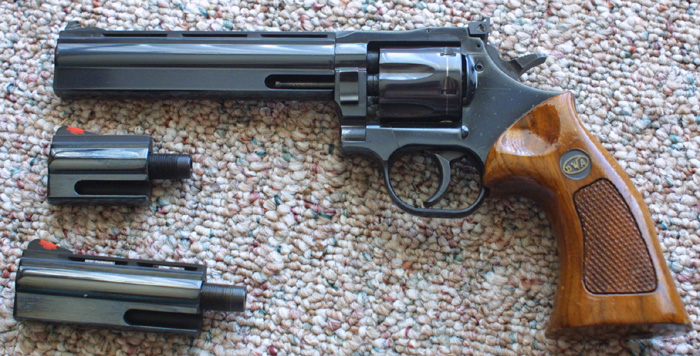 Throughout the years, the Dan Wesson
series of revolvers has retained a loyal, and dedicated following.
This despite the rising and falling tides of the company, the difficulty
of supply, and uncertainty over parts, and some years of rather uneven
quality. Through it all, these have retained their popularity, because
they remain the most versatile, accurate revolvers made. Innovation,
and versatility have become the hallmark of the Dan Wesson company. I
have, over the years, owned a number of these ground breaking revolvers.
In an era in which the cutting edge of handgun development is assumed to
be well centered within the realm of the automatic pistol, Dan Wesson saw
a future in innovation of the revolver.
Throughout the years, the Dan Wesson
series of revolvers has retained a loyal, and dedicated following.
This despite the rising and falling tides of the company, the difficulty
of supply, and uncertainty over parts, and some years of rather uneven
quality. Through it all, these have retained their popularity, because
they remain the most versatile, accurate revolvers made. Innovation,
and versatility have become the hallmark of the Dan Wesson company. I
have, over the years, owned a number of these ground breaking revolvers.
In an era in which the cutting edge of handgun development is assumed to
be well centered within the realm of the automatic pistol, Dan Wesson saw
a future in innovation of the revolver. The most striking feature of the gun is the capability of changing barrel length, by the use of an ingenious system of interchangeable barrels and shrouds. While there are other unique qualities to the Dan Wesson series, the fame of the system rests on the barrels. Even so, many if not most, Dan Wesson owners stick to a single barrel length, and often can not even recall the location of the tool used to change the barrel. In many cases it is the great accuracy, and light trigger pull which attracts buyers. These are some of the most accurate handguns in the world, and may very well be the most accurate repeating handguns ever made. They have also been constructed with very light, very simple actions, and the interchangeable barrel feature, for which they are best known. It doesn't hurt that the guns are very handsome, since the redesign. There is an almost pythonesqe look to the ribbed, and underlugged barrel. The deep blue is almost black, and has a mirror finish.
The gun shown above is the 22 version of the Dan Wesson medium frame revolver. One of the many innovations that the Dan Wesson company has made, is in the variety of calibers which are offered. Dan Wessons are (or have been) offered in .22, .22 Magnum, 32 H&R Magnum, 38/357, 41 magnum, 44 Magnum, 45 Rowlan, 45 Long Colt, 445 Magnum, 357 Maximum, 44 Maximum, 32-20, 414, and 378. There are probably others, and special models with special chamberings have been offered to silhouette shooters, through various organization. In many cases, these chamberings can only be found in a Dan Wesson, or a Thompson Contender. A few were tried by other revolver manufacturers, but abandoned (like the max cartridges).
The interchangeable barrels, give the shooter an opportunity to have, what is in essence, an entire revolver collection, in a variety of barrel lengths, while only needing to purchase a single gun. While this is certainly an economical way to own, what is functionally, an entire range of handguns at a
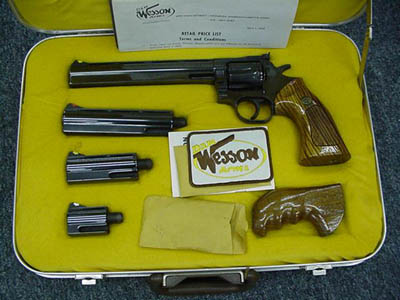 considerable savings in cost, the system has even more
significant advantages for some gun owners, in some legislative environments.
For people in some parts of the world, and even in some parts of the
United States, gun ownership is fraught with obstacles and restrictions.
People in these places can be limited in the number of firearms they
may own, or in the number they can purchase during a given time period.
There may also be licensing requirements, including fees (which can
be quite high, in some places), for each gun owned. For some gun owners
in these places, the option of owning a complete set of revolvers, in various
barrel lengths, is not an option, even if finances are no problem. Even
for the gun owner not so burdened, there might be a desire to have a full
set of barrels, to extract the maximum utility and versatility from the
gun, or simply to have a "complete" set.
considerable savings in cost, the system has even more
significant advantages for some gun owners, in some legislative environments.
For people in some parts of the world, and even in some parts of the
United States, gun ownership is fraught with obstacles and restrictions.
People in these places can be limited in the number of firearms they
may own, or in the number they can purchase during a given time period.
There may also be licensing requirements, including fees (which can
be quite high, in some places), for each gun owned. For some gun owners
in these places, the option of owning a complete set of revolvers, in various
barrel lengths, is not an option, even if finances are no problem. Even
for the gun owner not so burdened, there might be a desire to have a full
set of barrels, to extract the maximum utility and versatility from the
gun, or simply to have a "complete" set. In acknowledgment of this, Dan Wesson Arms has always offered sets, generally called either Pistol Packs, or Hunter Packs. The Pistol pack contains a Dan Wesson frame, along with a selection of barrels (21/2", 4", 6", and 8" for the medium frame model), the changing tool, a grip selection, a variety of interchangeable sights, and a vanity item such as a belt buckle or patch. The whole collection is packed in a fitted case. These have been offered in a variety of finishes, barrel styles, and calibers. The Pistol Pack shown here is representative of these guns during their greatest popularity, around the late seventies/early eighties. This was the Model 15-2 in .357 Magnum, the most popular of the series.
Some barrel units (shroud, nut, and barrel tube) are shown below. To demonstrate the design, I have inserted the tubes into the shrouds, in some cases. This is for illustration purposes only. In practice, the tube, with the barrel nut removed, would first be screwed into the frame. A feeler gauge is set between the barrel, and the cylinder, and the tube is tightened until it is snug with the feeler gauge, thus setting the barrel cylinder gap. The feeler gauge is then removed. Once the barrel tube is properly in place, the shroud is fitted over it, and aligned with the frame by use of an index pin on the frame, and a matching index hole in the shroud. After the shroud is fitted, the barrel nut is placed on the end of the barrel, and snugged down, using a special tool provided with the gun. The sights will then have to be adjusted, making the pistol ready to fire. The whole procedure, except for the setting of the sights, can be done in a few minutes.
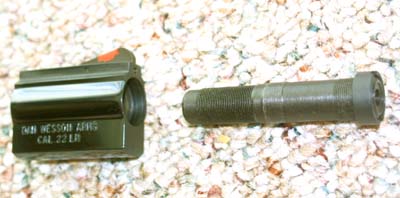
|
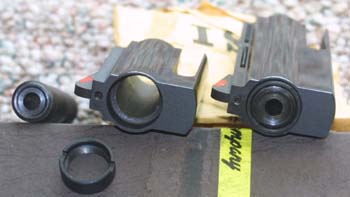
|
| Upper left: a barrel tube, with barrel nut, in position to be inserted into shroud unit. Upper right: a four inch shroud, with barrel inserted, sits next to a 2 inch shroud with barrel removed. The barrel is to the left of the two inch unit, and the barrel nut sits in the foreground. Below: barrel and shroud units, as seen from the back. Note the small hole on the shrouds for indexing to the frame Right: Top view of shroud units with and without barrel tube inserted. The barrel tube is to the far left of the photo..
|
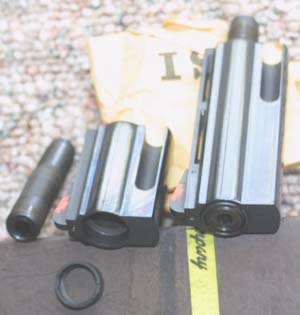
|
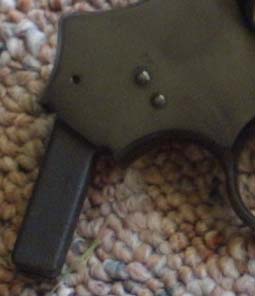 Dan Wessons. The grips are held to the frame via a small
nub, or socket, which is threaded, and sticks out of the back of the
frame. This permits the designers great latitude in the configuration
of the grip panels. Really, a grip of any size or shape may be hung
off of the bottom of the frame, and some Dan Wesson pistol packs came
with grip blanks, which could be carved into any shape the owner wished.
Dan Wessons. The grips are held to the frame via a small
nub, or socket, which is threaded, and sticks out of the back of the
frame. This permits the designers great latitude in the configuration
of the grip panels. Really, a grip of any size or shape may be hung
off of the bottom of the frame, and some Dan Wesson pistol packs came
with grip blanks, which could be carved into any shape the owner wished.
The internal parts are simple, robust, and multifunctional. Compared to the intricate clockwork of parts making up the internal mechanism of traditional revolvers, the Dan Wesson seems quite basic. The simplicity of the action gives it an almost unrivaled sturdiness. There is little to go wrong, and the action lacks the maddening collection of small springs, and levers which festoon the more traditional revolver designs. The action was designed, like the interchangeable barrel system, by Karl Lewis, and patterned after that of the Trooper which he had previously designed for colt. One allowance which has to be made for the new, simplified action, is in the placement of the cylinder latch. The latch on the Dan Wesson is located on the crane, rather than in the more traditional spot on the frame behind the cylinder. The cylinder is held at the rear, by a spring loaded ball bearing, while at the front it is held by the locking of the crane to the forward area of the frame. Colt, S&W, Ruger, and virtually every other revolver maker, use a latch on the frame which locks the cylinder at the rear. The S&W revolvers also lock at the front section of the ejector shroud, via a small pin which runs up the inside of the ejector itself. The only other action, of which I am aware, which locks at the crane, is that of the massive Taurus Raging Bull, in 454 Cassul, and 44 Magnum.
The meeting was fortuitous for both men. Dan Wesson was looking for a way out of the company his grandfather, Daniel B Wesson had cofounded, a century before. S&W had been bought in 1965 by Bangor Punta, a Brazilian concern, which would later divest itself of S&W, and it's Brazilian production facilities (which would later become Taurus). The new conglomerate was bottom line focused, and did not have the type of dedication to gun making for which Dan Wesson could have wished. So with Dan Wesson's famous name, and dedication to quality, and Karl Lewis' groundbreaking revolver design, the two men introduced the first new concept in revolvers in nearly a century.
The new company initially had no production facilities. Production of the early guns was contracted out to the High Standard company. Eventually, Dan Wesson moved to it's own facilities located in a converted public school, located in Monsoon Massachusetts. This was a modern facility, for it's day, and was able to produce high quality firearms at a relatively low cost. The shop was also owned and run by gun enthusiasts, and was small enough that innovation, and variety were fairly easy to accomplish. High Standard continued to produce the design under it's own name for a time. The High Standard revolver had the styling, including the crane mounted cylinder latch, and the lockwork of the Dan Wessons, but without the interchangeable barrel feature. A large framed revolver was latter produced by High Standard, under the name of the Crusader. Though it's styling was quite different, the lockwork showed some of the influence of the Dan Wesson series.
Unfortunately the company had undergone many changes including the death of it's founder, in 1978, and the death of Karl Lewis. It's financial fortunes have also risen and fallen. The company went under in 1989, but was brought back on line, in 1990. The new company was set up in Palmer MA, by Dan Wesson's son Seth, but was only able to stay in business for four years. By this time, the tooling, and machines were getting old and worn, the quality was going down, and the demand was slackened by the unpredictability of production, and uncertainty as to the longevity of the company. Many who had heard of the closing of the Monsoon plant, were unaware that the company was back.
I feel the need here, to clarify a few things, about the Palmer guns. These were not bad guns; but are considered to be somewhat less desirable, by the Dan Wesson faithful. The reason for this is a simple one - quality control. Anyone who works in manufacturing knows that a certain number of lemons are made by every factory, no matter how good the workers and machinery may be. It is the job of the quality control people to see to it that these do not make it out of the factory. When the new company opened its doors in Palmer, it was facing a number of difficulties, not the least of which was a soft market for revolvers. There were also financial problems, which made company managers look for new ways to save money. In some cases this meant cutting corners. the worst corner cut was that of quality control. So while the Palmer Dan Wessons were as well made as anything that had come out of Monsoon, some guns got on dealers shelves, that should never have been allowed to leave the factory. The two most common complaints were rough chambers, and barrel liners that were not perfectly squared. Both can be easily fixed; but this is not something that should be required of a new gun. This hurt the company pretty badly, all out of proportion to the small number of bad guns that got onto the market; but it was enough. The Palmer guns quickly developed a reputation for poor quality that remains to this day.
The reasons for the companies problems are the flip side to the innovative design of their guns. Gun enthusiasts can be a very conservative lot and can be very wary of "gimmicks". This was one of the reasons for the slow initial acceptance of the now highly regarded Glock line of pistols. Unlike Glock, Dan Wesson had no government orders to keep his company alive while he waited for a retail market to develop. Besides a natural wariness of untried innovations, there is also the matter of the touchiness of the guns, which is addressed in the section below. It also turns out that the interchangeable barrels did not give the gun the easy versatility that was originally envisioned. The problem was that, after switching barrels the guns often had to be re zeroed, and the cylinder barrel gap had to be reset. This had to be done at each change, and required a fair amount of effort, time, and ability. These factors tended to narrow the market for these fine, but somewhat demanding guns.
These fine revolvers are only in limited production today, and I have not seen a new Dan Wesson in a gun shop in ages. The new Dan Wesson Company began production in 1997, and ended in 2008, though occasional, limited runs are promised. The new revolvers are rather expensive, but the quality is very high, and the new owners seemed very serious about staying in for the long haul. In acknowledgment of this, they have completely retooled, and modernized the factory. The old Dan Wesson plant and tooling were judged to be beyond salvage, and a new plant was set up, with new CNC production stations, and laser engraving units, in Norwich New York. The single most encouraging thing about the new company was that, once again, Dan Wesson was under the charge of a single individual. Bob Serva owned the new works, continues to run them, for CZ, and seems genuinely enthusiastic about his product.
The new company was very much dedicated to innovation, in the spirit of the original works at Monsoon. New products, calibers, finishes, and accessories came out with such frequency that it is beyond the scope of this little essay to track them. Interested parties should check out the Dan Wesson Firearms website. One new area that the company moved into was the production of 1911 pattern pistols (the Pointman series), and also of bolt action rimfire rifles (the Coyote - now discontinued). All of the reviews, and reports of the new Dan Wesson product line have been favorable. While many firearms producers are running for cover, coming out with new politically correct firearms, pandering to the anti-guners, and pursuing the police, and government markets, the new Dan Wesson company has been very pro Second Amendment. They are not ashamed of being gunmakers, apologetic about the fact that civilians own (and sometimes use) their products, or patronizing of their customer base. Unlike some other firearms companies (Colt, and Ruger both come to mind), the Dan Wesson company appears to have no doubts or confusion about what business it was in.
The Dan Wesson company is now owned by the huge CZ firearms conglomerate. This company is well known for it's line of 9mm, and 40S&W semi auto pistols, and is essentially the old Czech BRNO state gun works, gone private. The company began to grow in leaps and bounds, a decade or two ago, after the fall of the Soviets. Having gone private, CZ now has an extensive consumer line of rifles, and pistols.
Though it initially seemed that CZ had no interest in revolver production, this rumor, which I am sorry to say that I helped to spread, turns out to be false, at least at first. Unfortunately, a look at the initial CZ/Dan Wesson website gave a fair amount of information about the Pointman series, but made no mention of any sort of revolver line. This gave the misleading impression that the revolver line had seen it's final glory. Still, production today will be limited to a custom shop, in the manner of Colt, or of some of the special offerings of S&W.
It is hoped that alliance with the comparatively large CZ company will increase the market, and the resources available to the Dan Wesson company, which had until then been going it alone in competition with relative giants of the industry. S&W, Colt, Walther, Winchester, Remington, and Savage are all well over a century old. Ruger, High Standard, and Springfield Armory have been in constant operation for decades. Beretta has been around since it began to manufacture canon barrels in the sixteen hundreds. All of these companies have well established dealer and distribution networks. Dan Wesson, on the other hand, has been in business for a bit over thirty years, and in it's present incarnation had only existed independantly for about the eight. The new alliance should help the company to compete on a more even footing with the larger companies.
In response to the exceptional ugliness ( a matter of taste; certainly there are some who thought their guns lovely) of the early guns, the Dan Wesson company drastically redesigned it's line in the late
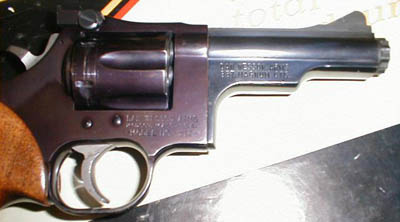 seventies. The early guns, before the Model 14, had an
odd unfinished look to them, as if they had been put together in someone's
basement, and the builder, gone off on some new project, would soon
come back to complete construction. The main cause of this unsightliness
was centered around the mechanism of the interchangeable barrels. The
nut at the end of the barrel, used to hold barrel, and shroud together,
hung off the end of the muzzle like some sort of an afterthought. This
made the guns appear remarkably like one of those zip guns you sometimes
see in prison exposé's. The barrel shroud itself had an odd looking
extension protruding from the bottom. This was used to index the shroud
to the frame, but it looked rather odd. Lastly, was the molded in shroud
for the rear sight. It made the frame look humpbacked, and seems as if it
might interfere with the mounting of a new rear sight. Taken together, these
things made the gun awkward looking. All of these cosmetic deficiencies were
changed. The barrel shroud now indexes using a frame mounted pin and an
index hole in the underbarrel lug. The barrel nut is now recessed inside
of the barrel shroud, which gives a much cleaner look, but now requires
a special tool to remove and install. It is also claimed, that the early
guns, with their shroud extensions, retained their point of aim better after
barrel replacement, and did not need to have the sights adjusted. So much
for the vanity of gun owners.
seventies. The early guns, before the Model 14, had an
odd unfinished look to them, as if they had been put together in someone's
basement, and the builder, gone off on some new project, would soon
come back to complete construction. The main cause of this unsightliness
was centered around the mechanism of the interchangeable barrels. The
nut at the end of the barrel, used to hold barrel, and shroud together,
hung off the end of the muzzle like some sort of an afterthought. This
made the guns appear remarkably like one of those zip guns you sometimes
see in prison exposé's. The barrel shroud itself had an odd looking
extension protruding from the bottom. This was used to index the shroud
to the frame, but it looked rather odd. Lastly, was the molded in shroud
for the rear sight. It made the frame look humpbacked, and seems as if it
might interfere with the mounting of a new rear sight. Taken together, these
things made the gun awkward looking. All of these cosmetic deficiencies were
changed. The barrel shroud now indexes using a frame mounted pin and an
index hole in the underbarrel lug. The barrel nut is now recessed inside
of the barrel shroud, which gives a much cleaner look, but now requires
a special tool to remove and install. It is also claimed, that the early
guns, with their shroud extensions, retained their point of aim better after
barrel replacement, and did not need to have the sights adjusted. So much
for the vanity of gun owners. Though the Dan Wesson series of revolvers were reliable enough, they did require a bit more attention than most shooters were used to having to give their guns. Once again, the problem centered around the unique, interchangeable barrels. The barrel cylinder gap of a revolver is a very precise adjustment. In the Dan Wesson, this adjustment is set when screwing in the barrel. As a result of this, the barrel cylinder gap of a Dan Wesson can change over time, and should be periodically checked with a gauge which is provided with the pistol. This is not a problem for competitive shooters who are used to codling
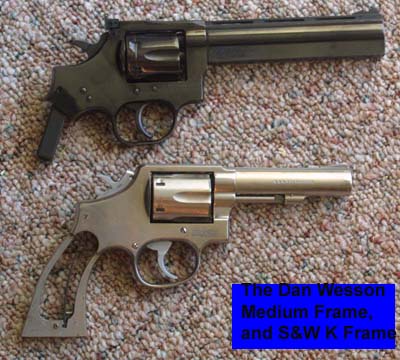 their guns, but it is more maintenance than the average
shooter cares to favor his gun with.
their guns, but it is more maintenance than the average
shooter cares to favor his gun with. Smith and Wesson, Ruger, Colt, and virtually all other revolver makers, either pin, crush, or braze the barrels of their revolvers, into the frames. These methods make barrel replacement on these guns very difficult, of not impossible. The screw in barrels of the Dan Wessons are different. Unlike the barrels of most revolvers, those of the Dan Wessons can, and do, work loose. This is not to say that they are in danger of falling off of the pistol, but they loosen to the extent that the barrel cylinder gap can change. This can adversely affect the accuracy of the gun, reduce velocity, and cause the gun to shave the bullets. A gap which is too tight will cause the cylinder to bind against the barrel, freezing up the action, and possibly locking the gun so that it must be disassembled. A gap which is too loose will reduce velocity, and accuracy. A barrel nut which is not properly tightened, or has been shot loose, can allow the barrel to sag, or twist in the frame. This destroys accuracy, and may even damage the barrel over time.
In an ordinary pistol, such things mean an expensive trip to the gun smith for barrel replacement, action tuning, or frame straightening. With the Dan Wesson, the matter is taken care of by simply inserting the gauge provided with these guns, and tightening up the barrel. Unfortunately, many gun owners did not bother to acquaint themselves with the special needs of these pistols, and simply passed these "failures" off as the result of a poor design, or poor construction. Because of this, these fine pistols earned an undeserved bad reputation, for many years. The solution to this problem is owner awareness. Unfortunately, owner awareness is not something that can be adjusted at the factory. Dan Wesson owners need to get into the habit of occasionally checking the gap, using the tool provided, and of verifying the tightness of the barrel nut. These things take only a minute or two, and need not be done for months. I check mine, maybe once or twice a year.
The trigger pull of the Dan Wesson, if you are an aficionado of such things, is a bit strange. Some shooters don't seem to notice, while others seem to love it. I suppose it is an acquired taste, for those of us weaned on the old S&W K and N frame revolvers; many never quite get used to it. The double action pull is very light, though the weight of pull seems to change through the trigger arc. It reminds me of the pull on the Ruger Redhawk series of guns. What seems to disturb most shooters is the arc of the hammer. It is shorter than that of the standard S&W, and cocking a Dan Wesson for the first time feels a bit odd. This is probably the shortest action of any revolver. Though you would expect such an action to generate a heavy trigger pull, the pull remains very light. This is a matter of personal taste, and the top scores earned by competitors using these guns, is proof enough that the trigger can be mastered. I suspect it is more a matter of what one is used to, and that shooters weaned on the Dan Wesson, might find transition to the trigger of a classic S&W revolver strange.
As much as I enjoy my S&W revolver collection, the Dan Wessons are my favorites. I consider these to be the ultimate revolvers.
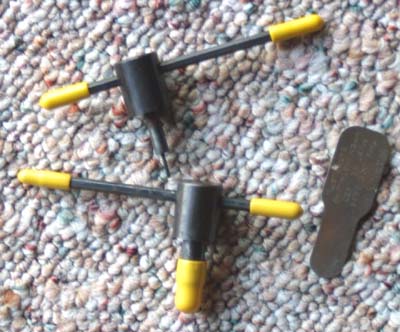
|
In order to change a Dan Wesson barrel,
you will need a barrel wrench, and a gap tool. You will only need
one wrench. Of the two shown in this photo, one is for the 22, and
the other is for the 357. The feeler gauge is the sliver of metal shown
to the right of the photo. It is .006". the Dan Wesson company emphasizes
that you must use the feeler gauge when changing barrels. |

|
Shown here is everything needed to
change from a 6 inch barrel to a two inch barrel. |
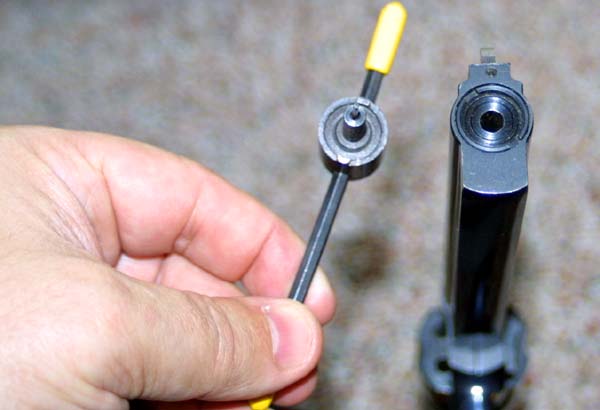
|
The barrel wrench shown alongside
the muzzle. The two notches on the barrel nut mate with a pair of
cams in the wrench. In the absence of a barrel wrench, I have used
needle nose pliers to mate with the notches in the barrel nut, but I
absolutely do not recommend this as it can tear up the nut. |
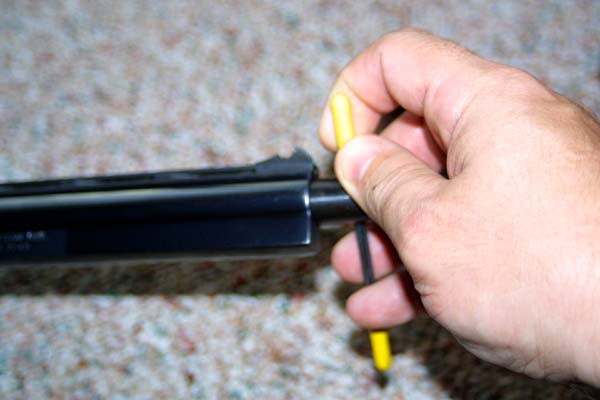
|
Using the special tool, loosen and
remove the barrel nut from the muzzle. They generally come out pretty
easily, but occasionally some muscle will be required. |
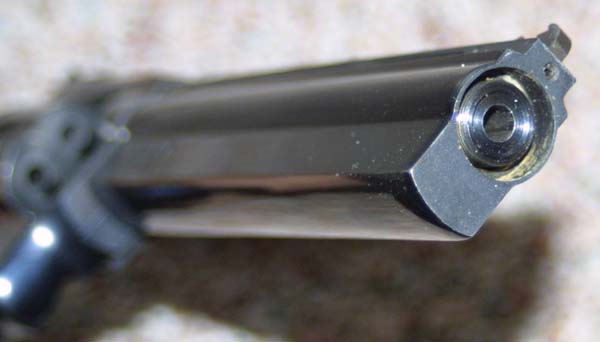
|
A view of the muzzle with the barrel
nut removed. The powder seen inside of the shroud is from grease, put
in at the factory when the gun was manufactured over 25 years ago. |
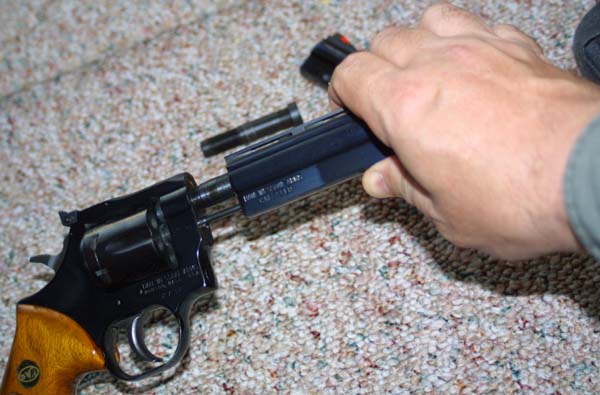
|
After removing the barrel nut, pull
the barrel shroud off of the barrel. |
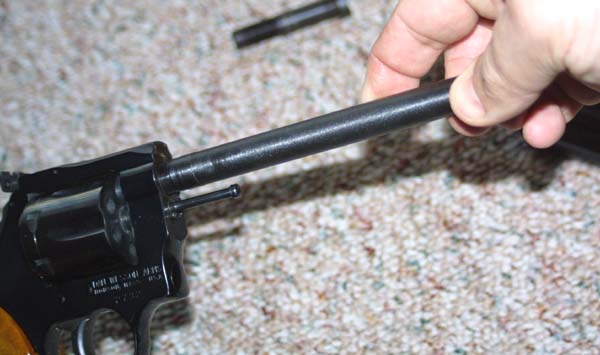
|
With the barrel shroud removed, it
is a simple matter to unscrew the barrel tube from the frame. |
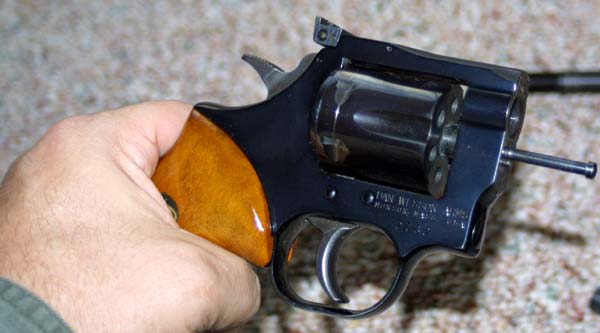
|
A side view of the Dan Wesson medium
revolver frame (22 version) with the barrel removed. |
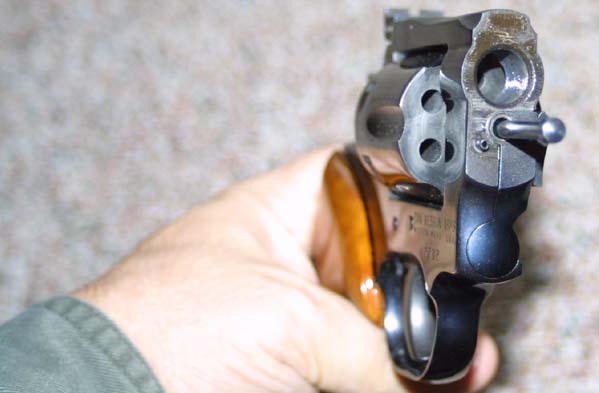
|
A front view of the medium revolver
frame with the barrel removed. Those 22 caliber holes look pretty
small in this 357 sized cylinder and frame. |
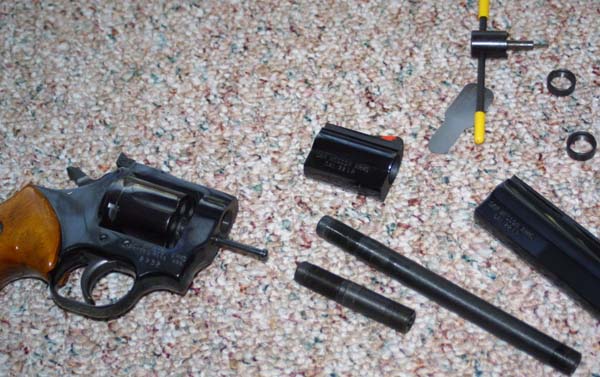
|
Parts are scattered around the work
area. Seen in the photo are shrouds, barrels, and barrel nuts for
the 2.5, and 6 inch barrels, as well as the barrel wrench, and the
feeler gauge. I am about to put the shorter barrel in place. |
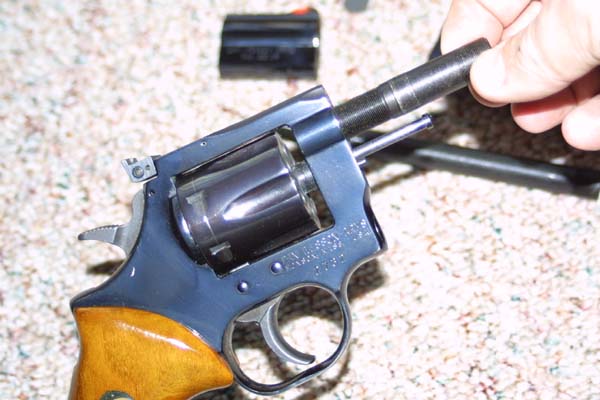
|
The first step is to screw in the
new barrel tube. |
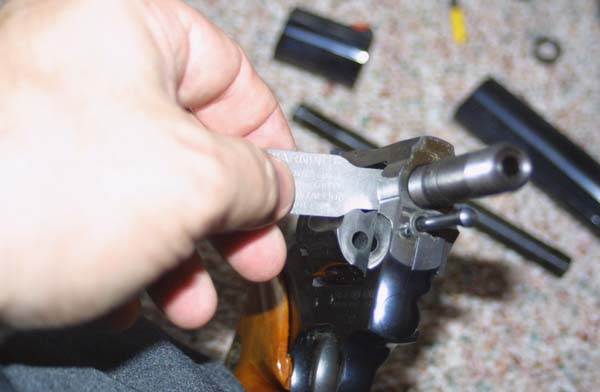
|
Using the feeler gauge, adjust the
barrel cylinder gap by snugging the barrel up against gauge. |
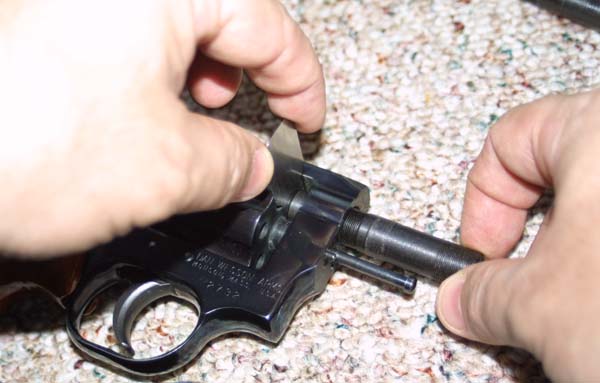
|
The barrel is snugged up against the
gauge as it is held in place against the cylinder. The barrel is tightened
until it is resting on the gauge, but still lose enough to allow easy
removal. The gauge is then withdrawn, as the gap is then properly set. |
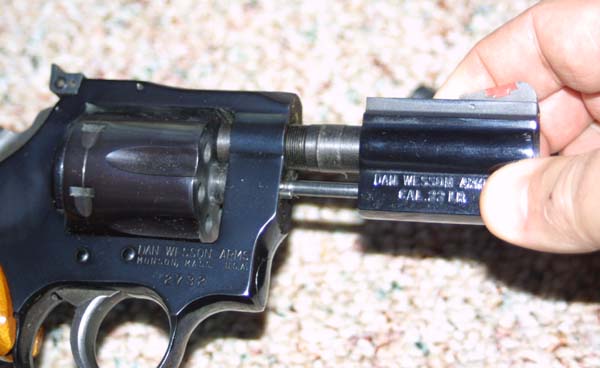
|
With the barrel properly installed,
place the shroud over the barrel. It will line up with an index pin
on the front of the frame. |
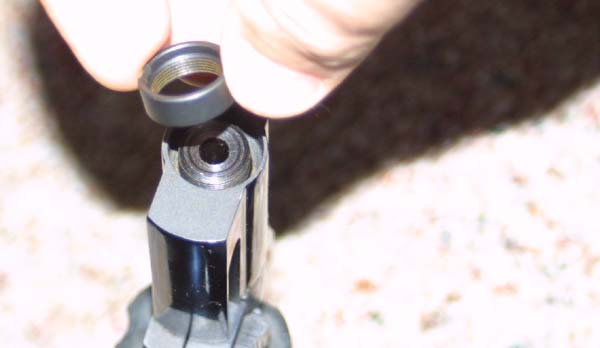
|
Center, replace, and tighten the barrel
nut. |
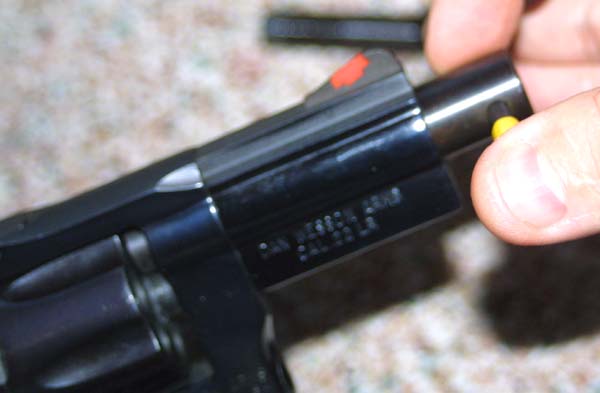
|
Use the barrel wrench to recess, and
tighten the nut. There should be not play in the nut or the barrel.
Every few months it is a good idea to snug up the nut, and to use the
feeler gauge to check the gap. |
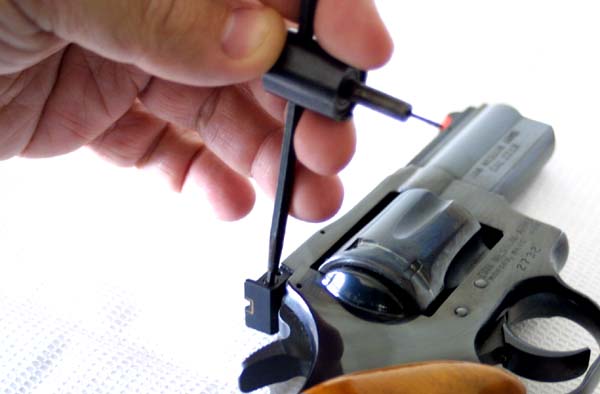
|
Sights may need some adjustment. This
is easily done. The barrel tool also doubles as a sight tool. |
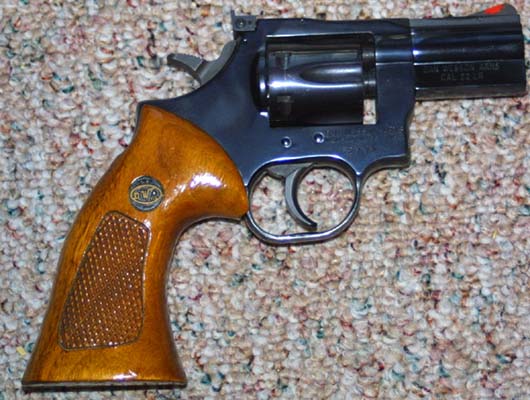
|
I now have a 22 snub nose (with,
admittedly, overly large grips) where I had formerly possessed a 22
target revolver with a six inch barrel. The Dan Wesson is a wonderful
gun, and a remarkable design. |
| The large, hand filling target grips are great
for accuracy, but do not do much for the concealability of the pistol,
once the shorter barrel is in place. A single screw holds the grips in place,
and it is easily removed, using the barrel tool. |
|
| The two inch Dan Wesson, awaiting a more appropriately
sized set of grips. |
|
| Here is everything needed to change the grips.
Note that these are all one piece grips, held in place with a single screw,
shown below the frame. |
|
| After sliding the new grips over the nub at
the bottom of the frame, the grips screw is slid in place, and then tightened
with the barrel tool (also known, appropriately enough, as the combination
tool). |
|
| The new grips, make the little two inch gun
a bit easier to conceal, and more streamlined. They also are better proportioned
to the shorter barrel. |
The Dan Wesson revolver comes in essentially
two frame styles. There is the medium, and the large frame. For
a short time, the company was offering a pistol called the Lil' Dan,
which was a small .38 Special revolver with a short barrel. Presumably
the frame was of reduced size and weight, but I have never had my hands
on one, and only know what I have read. I believe it only had a five
round capacity, but I could be wrong about this.
Of the two common Dan Wesson
frame sizes the medium frame, is similar in size to that of the Colt
Python, and the more recent S&W L frame. This is considered to be
a 41 frame, though no company (including Dan Wesson) builds a 41 revolver
upon a frame this size. In the case of Dan Wesson, this frame is used
as a platform to produce revolvers chambered for the 357, 38, 22, 32, and
perhaps some other calibers. This is a larger and heavier frame than the
traditional K frame upon which S&W has built the majority of it's service
revolvers.
The Large Dan Wesson
frame is used to produce guns chambered in 44 Magnum, 41 Magnum, and
several different 45 calibers. These frames are sized approximately the
same as the Ruger Redhawk, making them quite a bit heavier and more robust
than the classic N frame from S&W.
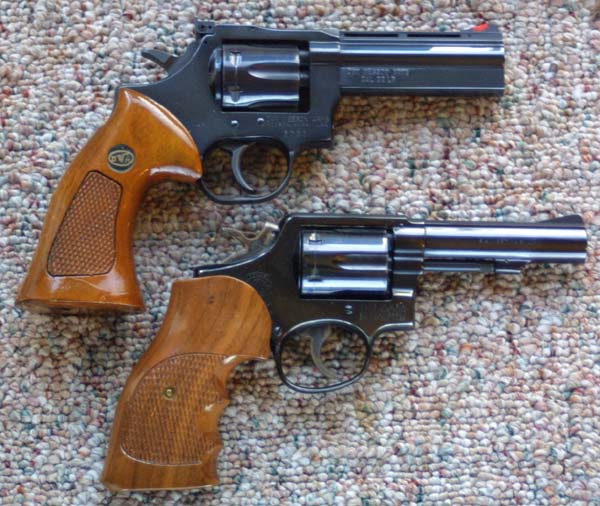
|
This photo shows a pair of blue, medium frame revolvers with four inch barrels. The uppermost is a Dan Wesson, in this case chambered for the 22 Long Rifle, while the lower is a S&W K frame 357 revolver; in this case a model 13. The 357 version of the Dan Wesson is identical except for the chambering. As can be seen here, the Dan Wesson frame is heavier than that of the classic Smith. |
| This photo shows a pair of eight inch revolvers.
The uppermost is a S&W 629. This is an N frame revolver chambered
for the 44 magnum. Until the X frame was introduced for the new 500 S&W
cartridge, this was the, largest revolver frame that Smith made. Below
it is the medium frame Dan Wesson. This is the same sized frame as is used
in the blue 22 Dan Wesson revolver in the photo above. |
|
| This photo shows a pair of 44 magnum revolvers
with six inch barrels. The top revolver is a Dan Wesson, while the one
below is the classic S&W M-29 of Dirty Harry fame. The extra bulk of
the Dan Wesson is pretty apparent in this photo. The Dan Wesson in this
photo is in the white, as it is being prepared for refinishing. |
| Dan Wesson 22 VH Blue | Dan Wesson 15VH .357 Nickel |
| Dan Wesson 44VH Nickel | Dan Wesson 715VH .357 Stainless |
| Dan Wesson 744VH Stainless |
Dan Wesson 741VH Stainless |
| Restoring a Dan Wesson 44 | Making a 44 Snubnose |
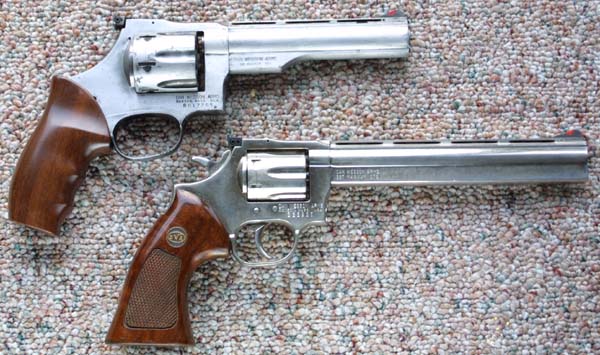 I have the three most common chamberings of
the Dan Wesson revolvers, that is the 357/38, the 22, and the 44 Magnum.
I would like to add a 41 Magnum to the collection, and perhaps a nice
45 Rowland. The 32, 22 magnum, and maximum cartridge revolvers don't
appeal to me. The Maximums were a great idea a decade or two ago, but
with today's line up of magnums, I really don't see the point any more.
I have the three most common chamberings of
the Dan Wesson revolvers, that is the 357/38, the 22, and the 44 Magnum.
I would like to add a 41 Magnum to the collection, and perhaps a nice
45 Rowland. The 32, 22 magnum, and maximum cartridge revolvers don't
appeal to me. The Maximums were a great idea a decade or two ago, but
with today's line up of magnums, I really don't see the point any more.
I would love to see Dan Wesson come out
with a 454 Cassul, or a 50 S&W, but perhaps I hope for too much.
A market has to exist for these things, and it seems that S&W
is having trouble selling it's own 500 Magnum revolver. I have noticed
a slight drop in prices, as opposed to the sharp increase, and gouging
that I recall from the days when the 44 Magnum was in it's prime. There
are stories of injured wrists, numb hands, and sore elbows surrounding
the regular use of these guns. It is also a little hard on the wallet to
own a gun which fires ammunition that costs $2 a round; this may be the
most painful part of ownership. Also, as always, firearms legislation looms
over every new development. Several states have already had bills introduced
to ban these guns as being too powerful for "legitimate sporting use" As
if legislators had any clue about sportsmanship, or legitimacy.
Parts and Availability
Sadly, production of new Dan Wesson revolvers is once again in jeopardy. As of this writing, there is no longer any mention made of new revolver availability. the website offers only barrel wrench/shim kits, replacement barrels, and replacement stocks. Still, the guns are widely available on www.gunbroker.com, and will sometimes show up at gun shows, or used in gun shops. The Dan Wesson company announced that from time to time, they will offer special runs of the guns, in the manner of the Colt Custom Shop; but will no longer offer regular production revolvers. So why did this happen?
A number of reasons suggest themselves. The main reason is likely the limited models and numbers of guns produced. The Alaskan Guide model was pretty much the only offering, for the last several years at least. Though these are great guns, they are not destined to be produced in large numbers. S&W could probably not stay in business, selling only the new S&W 500. Reintroduction of a complete line of guns, in popular calibers, might have increased sales enough to save the revolver line. Revolvers are less popular, in general, than had once been the case, and while certain new production techniques can streamline semi auto manufacture, it is still expensive to make a good revolver. While the purchase of Dan Wesson by CZ may end up being a very good thing for the company as a whole, it may have been the final nail in the production of the revolver line. CZ does not make revolvers, and really has no place for them in its line. What CZ really wanted was an American manufacturer, and a company to make 1911 clones to compliment its already extensive line of 9mm/40 S&W autos.
As of right now, company contacts for revolver parts are as follws:
For parts contact Genny at 607.336.1174 and for service or repairs try 607.336.1174 ext 24.
5169 State Hwy 12, South
Norwich, NY 13815
607-336-1174 Ext# 21
607-336-2730 Fax
http://www.danwessonforum.com/
